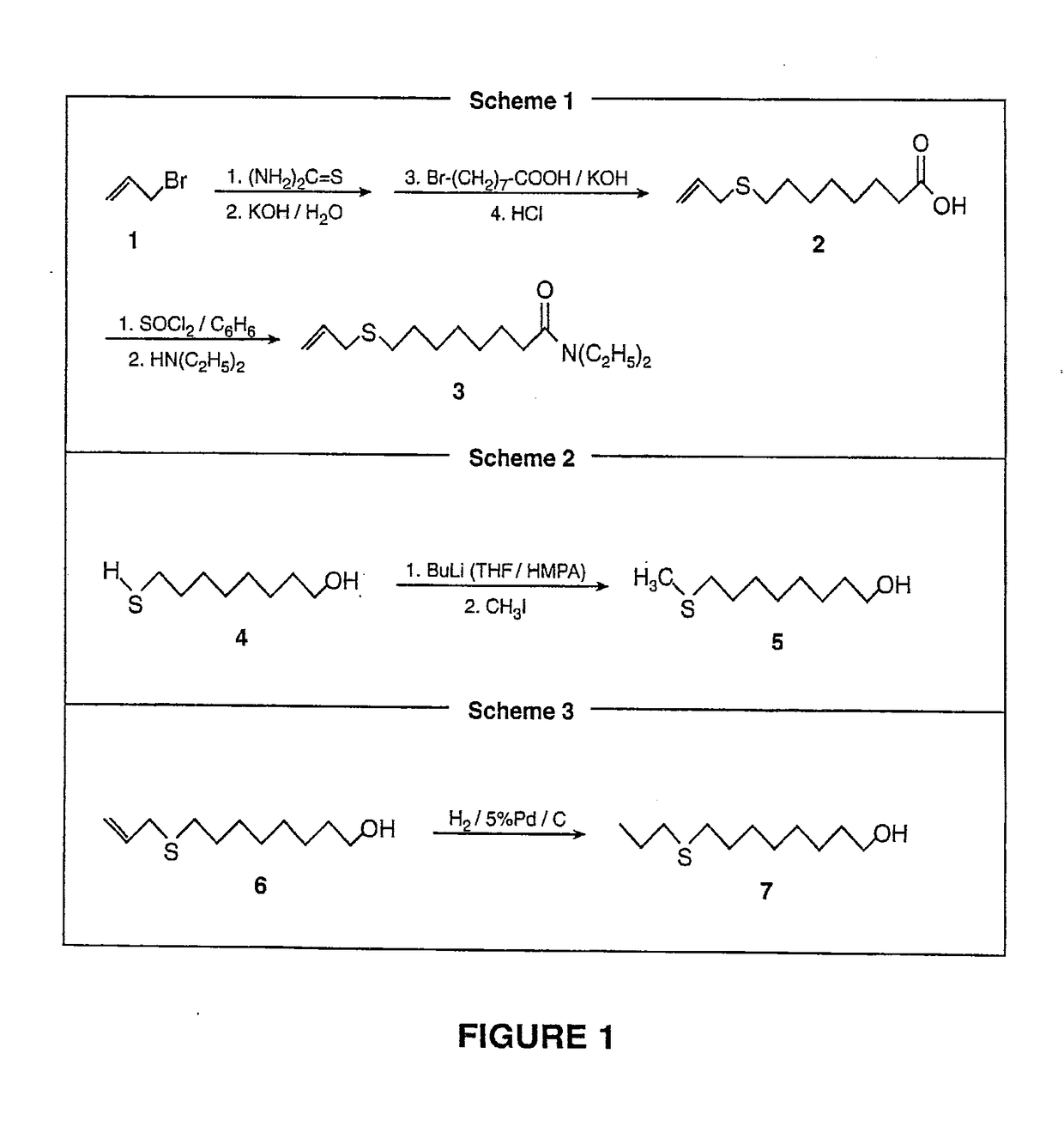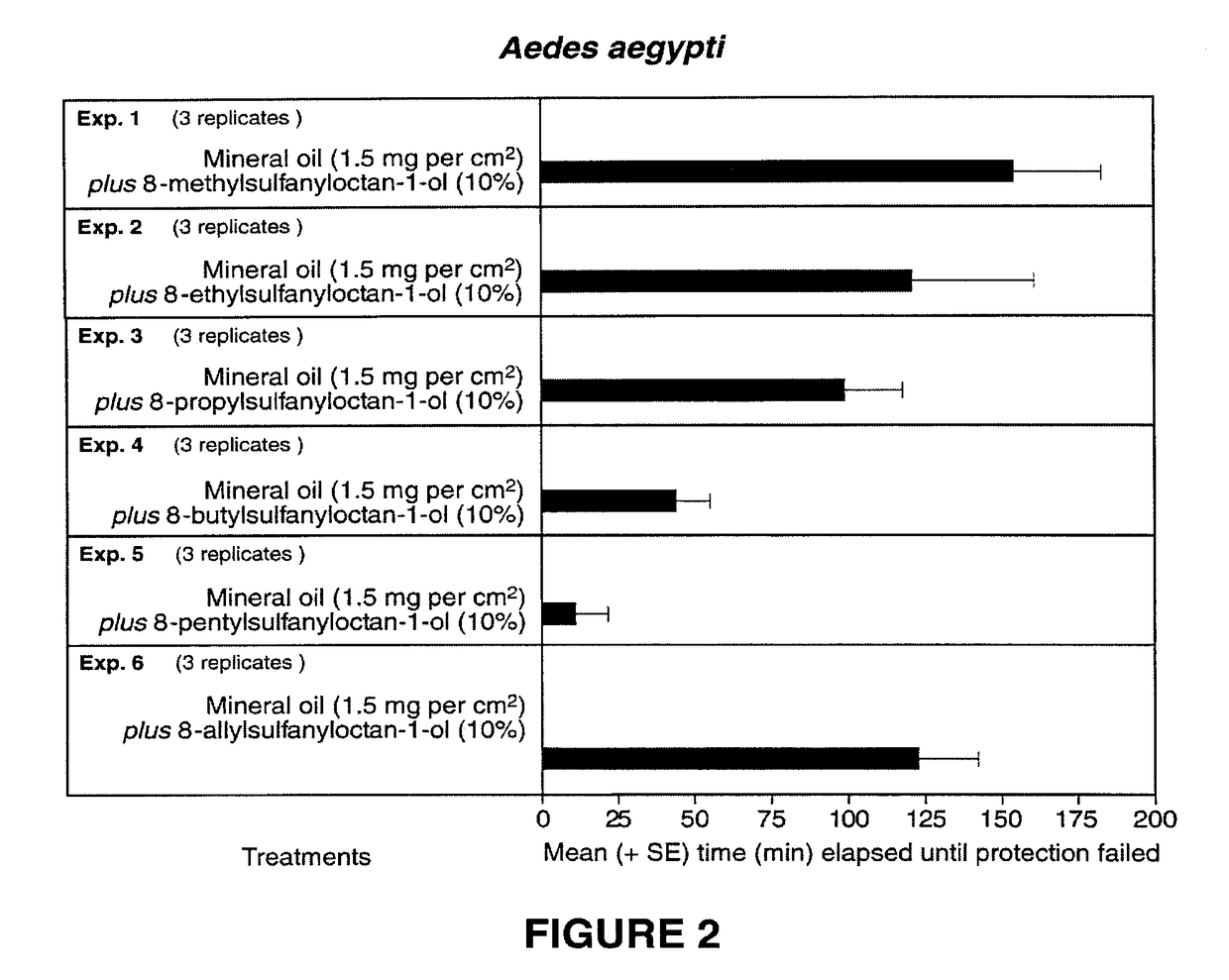Compounds and methods for repelling blood-feeding arthropods and deterring their landing and feeding
a technology of arthropods and compounds, applied in the field of compounds and methods for repelling blood-feeding arthropods and deterring their landing and feeding, can solve the problems that products exceeding 30% n, n-diethyl-m-toluamide are not recommended for children's protection, and achieve the effect of improving the repellent and deterrent effect against landing
- Summary
- Abstract
- Description
- Claims
- Application Information
AI Technical Summary
Benefits of technology
Problems solved by technology
Method used
Image
Examples
example 1
Experimental Insects
[0025]A black-eyed Liverpool strain of Aedes. aegypti was obtained from Dr. Carl Lowenberger, Simon Fraser University (SFU). Insects were reared under standardized conditions (60-70% relative humidity, 26-28° C., 14 h light:10 h dark photoperiod) in SFU's insectary. Neonate larvae that hatched in glass dishes of sterilized hypoxic water were transferred to trays of distilled water provisioned with Nutrafin® Basix Staple Food fish diet. Pupae were collected daily and separated by sex, and 15 females and 10 males were placed in a paper cup (7.5 cm diameter, 8.5 cm high) with a mesh lid. Emergent adults were fed a 10% (w / v) sucrose solution via braided cotton dental rolls. Arm-fed gravid females were offered water-containing paper cups, lined with paper-towel as an oviposition substrate.
example 2
General Bioassay Procedure
[0026]Candidate repellents and deterrents were bioassayed according to a modified protocol from the World Health Organization (1996). At least 1 hour prior to each bioassay, 75 host-seeking non blood-fed, nulliparous, 5- to 8-day-old female Aedes aegypti were placed into a wood-framed cage (26.5 cm on each side and 42.5 cm high) with a wooden floor, screened mesh sides and top, and a clear acrylic front fitted with a cotton stockinette sleeve (10 cm diameter). The test subject's arm was covered with an elbow-length polyethylene glove with an excised patch (16.6 cm long, 6 cm wide) to expose the ventral forearm of the test subject. Candidate deterrents were formulated in mineral (paraffin) oil and applied to the exposed forearm 5 min prior to inserting the arm into the cage. The inserted arm remained in the cage for 3 min every 30 min. Prior to each 3-min bioassay period, the hand of the untreated arm was inserted into the cage to ascertain that it received ...
example 3
Synthesis of (N,N)-Diethyl-8-allylsulfanyl-octanamide (FIG. 1, Scheme 1)
[0028]A mixture of allylbromide (1, 1.30 ml, 15 mmol) and thiourea (1.45 g, 15 mmol) was refluxed in 50 ml of anhydrous ethanol for 3 hours and cooled to 25° C. Pellets of KOH (1.62 g, 30 mmol) were added together with water (0.30 ml). The reaction mixture was then refluxed for 2 hours. 8-Bromooctanoic acid was alkylated with potassium allylmercaptade (Jie et al. 1989) by adding to the reaction mixture 8-bromooctanoic acid (2.23 g, 10 mmol) and KOH (1.30 g), and refluxing for 5 hours under argon. Thereafter, water (50 ml) was added and the reaction mixture was extracted with hexane (2×40 ml). The aqueous solution was acidified with conc. HCl and extracted again with ether (2×40 ml). Ethereal extracts were washed with a saturated aq. NaCl solution and were dried over anh. MgSO4. Evaporation of solvents gave 8-allylsulfanyl-octanoic acid (2) (50% pure by GC); MS [m / z (rel. intensity)]: 216 (M+,100), 199 (26); 169 ...
PUM
| Property | Measurement | Unit |
|---|---|---|
| area | aaaaa | aaaaa |
| diameter | aaaaa | aaaaa |
| diameter | aaaaa | aaaaa |
Abstract
Description
Claims
Application Information
 Login to View More
Login to View More - R&D Engineer
- R&D Manager
- IP Professional
- Industry Leading Data Capabilities
- Powerful AI technology
- Patent DNA Extraction
Browse by: Latest US Patents, China's latest patents, Technical Efficacy Thesaurus, Application Domain, Technology Topic, Popular Technical Reports.
© 2024 PatSnap. All rights reserved.Legal|Privacy policy|Modern Slavery Act Transparency Statement|Sitemap|About US| Contact US: help@patsnap.com










